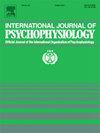遗忘性轻度认知障碍的皮质功能连通性改变。
IF 2.6
3区 心理学
Q3 NEUROSCIENCES
引用次数: 0
摘要
目的:遗忘性轻度认知障碍(aMCI)以情景记忆缺陷为特征,被定义为阿尔茨海默病的前驱期。因此,揭示痴呆症痴呆期大范围网络的功能障碍是至关重要的。本研究旨在探讨aMCI与健康对照组之间静息状态功能连通性的变化。方法:采用25例aMCI患者和25例健康对照(HC)的MRI和临床资料。使用CONN工具包在所有组织学分类的Brodmann区域之间进行种子到种子的功能连接分析。错误发现率(False Discovery Rate, FDR)校正用于校正多重比较,显著性阈值设置为pFDR-corr 结果:我们发现,与HC相比,aMCI组BA7与双侧BA33和右侧BA32之间的功能连接减少,并且这些减少与记忆衰退呈正相关。结论:本研究提示阿尔茨海默病痴呆前驱期楔前叶(BA7)与前扣带皮层(BA32-33)之间的连通性受到影响。利用组织学图谱研究遥远解剖区域间的内在功能连通性变化可能有助于研究痴呆的进展。本文章由计算机程序翻译,如有差异,请以英文原文为准。
Cortical functional connectivity changes in amnestic mild cognitive impairment
Objective
Amnestic mild cognitive impairment (aMCI) is characterized by episodic memory deficits and is defined as the prodromal phase of Alzheimer's disease. Therefore, it is critical to reveal the dysfunction in large-scale networks during the dementia phase of the disease. This study aimed to examine the resting-state functional connectivity changes between aMCI and healthy control groups.
Methods
MRI and clinical data from 25 individuals with aMCI and 25 healthy controls (HC) were used. Seed-to-seed functional connectivity analyses were performed between all histologically classified Brodmann areas using the CONN toolkit. False Discovery Rate (FDR) correction was used to correct for multiple comparisons, and the significance threshold was set at pFDR-corr < 0.05.
Results
We found that, compared to HC, the aMCI group showed reduced functional connectivity between BA7 and both bilateral BA33 and right BA32, and these reductions were positively correlated with memory decline.
Conclusion
Our study suggests that the connectivity between the precuneus (BA7) and anterior cingulate cortex (BA32–33) is affected in the prodromal stage of Alzheimer's disease dementia. Investigating intrinsic functional connectivity changes between distant anatomical regions by using histological atlases might be useful for investigating the progress of dementia.
求助全文
通过发布文献求助,成功后即可免费获取论文全文。
去求助
来源期刊
CiteScore
5.40
自引率
10.00%
发文量
177
审稿时长
3-8 weeks
期刊介绍:
The International Journal of Psychophysiology is the official journal of the International Organization of Psychophysiology, and provides a respected forum for the publication of high quality original contributions on all aspects of psychophysiology. The journal is interdisciplinary and aims to integrate the neurosciences and behavioral sciences. Empirical, theoretical, and review articles are encouraged in the following areas:
• Cerebral psychophysiology: including functional brain mapping and neuroimaging with Event-Related Potentials (ERPs), Positron Emission Tomography (PET), Functional Magnetic Resonance Imaging (fMRI) and Electroencephalographic studies.
• Autonomic functions: including bilateral electrodermal activity, pupillometry and blood volume changes.
• Cardiovascular Psychophysiology:including studies of blood pressure, cardiac functioning and respiration.
• Somatic psychophysiology: including muscle activity, eye movements and eye blinks.

 求助内容:
求助内容: 应助结果提醒方式:
应助结果提醒方式:


